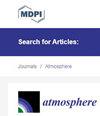Radon Equilibrium Factor and the Assessment of the Annual Effective Dose at Underground Workplaces
IF 2.3
4区 地球科学
Q3 ENVIRONMENTAL SCIENCES
引用次数: 0
Abstract
The equilibrium factor F is one of the parameters that should be considered when assessing the effective dose based on radon activity concentration. Since the equilibrium factor in various environments ranges theoretically from a value close to 0 to 1, it is expected that dose assessment based on one recommended coefficient value may lead to an underestimation or overestimation of the dose. That is why it is essential to measure this quantity if the basis for dose assessment is the radon concentration and not the concentration of radon decay products. The equilibrium factors were determined based on measurements of radon activity concentration and potential alpha energy concentration and varied from 0.15 to 0.94, with an arithmetic mean of 0.55. The average effective dose calculated for the employee taking into account these values was 31 mSv, assuming an annual working time of 1800 h. In turn, the average effective dose calculated for the equilibrium factor of 0.2 as recommended by the International Commission on Radiological Protection (ICRP) was equal to 13 mSv.氡平衡因子与地下工作场所年有效剂量评估
平衡系数F是根据氡活度浓度评估有效剂量时应考虑的参数之一。由于各种环境中的平衡系数理论上从接近0到1不等,因此根据一个推荐的系数值进行剂量评估可能会导致低估或高估剂量。因此,如果剂量评估的基础是氡浓度而不是氡衰变产物的浓度,就必须测量这个量。平衡系数是根据氡活度浓度和潜在阿尔法能量浓度的测量结果确定的,从0.15到0.94不等,算术平均值为0.55。而根据国际辐射防护委员会(ICRP)建议的 0.2 平衡系数计算出的平均有效剂量为 13 mSv。
本文章由计算机程序翻译,如有差异,请以英文原文为准。
求助全文
约1分钟内获得全文
求助全文
来源期刊

Atmosphere
METEOROLOGY & ATMOSPHERIC SCIENCES-
CiteScore
4.60
自引率
13.80%
发文量
1769
审稿时长
1 months
期刊介绍:
Atmosphere (ISSN 2073-4433) is an international and cross-disciplinary scholarly journal of scientific studies related to the atmosphere. It publishes reviews, regular research papers, communications and short notes, and there is no restriction on the length of the papers. Our aim is to encourage scientists to publish their experimental and theoretical research in as much detail as possible. Full experimental and/or methodical details must be provided for research articles.
 求助内容:
求助内容: 应助结果提醒方式:
应助结果提醒方式:


